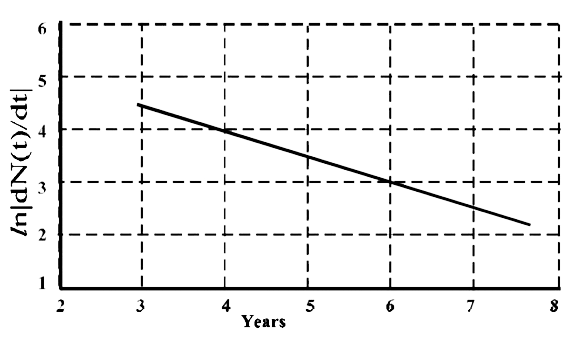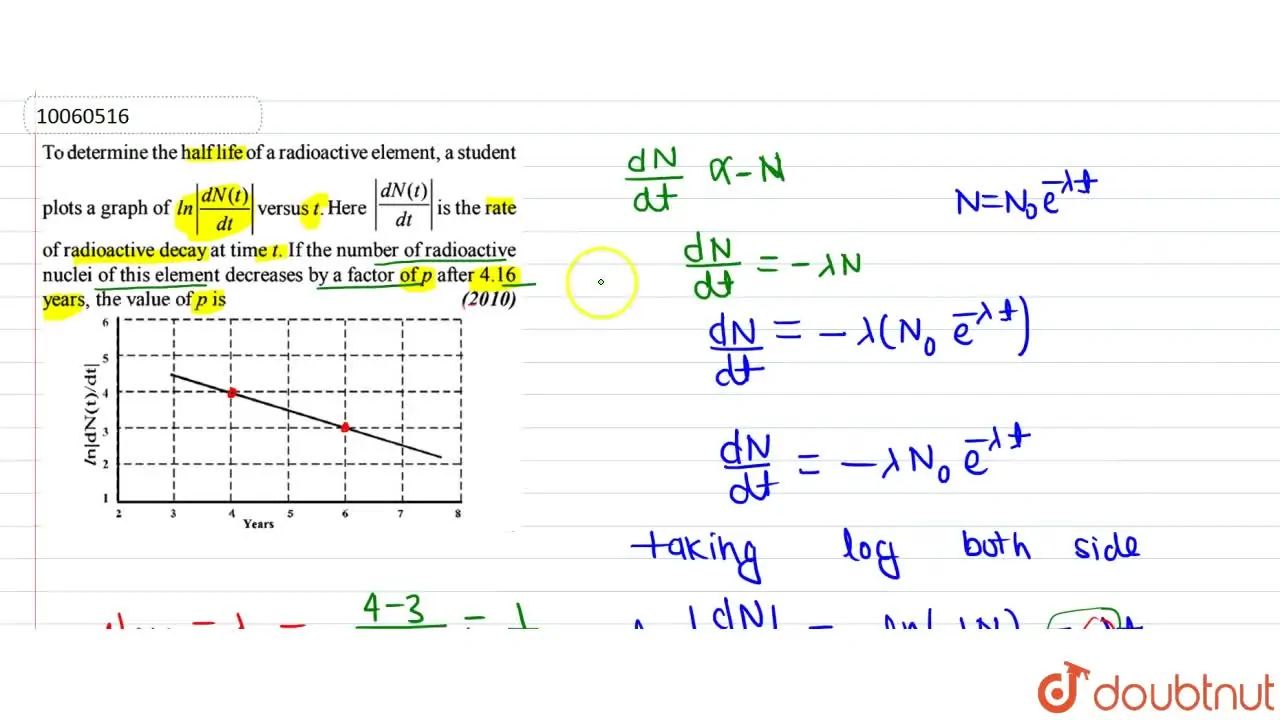To determine the half life of a radioactive element , a student plot a graph of in ∣∣∣dN(t)dt∣∣∣ versus t , Here ∣∣∣dN(t)dt∣∣∣ is the rate of radiation decay at time t , if the number of radioactive nuclei of this element decreases by a factor of p after 4.16year the value of p is

we know that N=N0e−λt
:. (dN)/(dt) = N_(0)e^(-u) (-lambda) = -N_(0)e^(-11)<br>Tak∈glogon⊥hss<br>(dN)/(dt) = log_(e) (-N_(0) lambda)) - lambda t <br>Compart∈gitwiththegraphl∈e<br>we≥tlambda= (1)/(2)gamma t^(-1) [(AC)/(BC) = (1)/(2))]<br><imga≤ocr_imageload∈g=lazysrc=https://d10lpgp6xz60nq.cloudfront.net/physics_images/JMA_MP_C17_173_S01.pngwh=80%mx-autosty≤=background:white;><br>:. T_(1//2) = ((0.693)/(lambda) = 0.693 xx 2 = 1.386 year<br>Now (N)/(N_(0)) = ((1)/(2))^(1)/(T_(1//2)) rArr (1)/(p)= ((1)/(2)) ^(4.13)/*(1.386)) = (1)/(8)
Related Playlists
- BOOK - SUNIL BATRA (41 YEARS IITJEE PHYSICS)CHAPTER - MODERN PHYSICSEXERCISE - MCQ (One Correct Answer1videos
MODERN PHYSICS
- BOOK - SUNIL BATRA (41 YEARS IITJEE PHYSICS)CHAPTER - ELECTROSTATICSEXERCISE - Comprehension Based Questions2videos
ELECTROSTATICS
- BOOK - SUNIL BATRA (41 YEARS IITJEE PHYSICS)CHAPTER - MOVING CHARGES AND MAGNETISMEXERCISE - MCQs(d )1videos
MOVING CHARGES AND MAGNETISM
Similar Questions
Draw a graph showing the variation of decay rate (−dNdt) with number (N) of radioactive nuclei.
View SolutionThe t0.5 of a radioactive element is related to its average life by the expression
View SolutionThe half life of a radioactive element is T and its initial activity at t=0 is A0 and at t=t it is A, then
View SolutionIf T is the half-life of a radioactive material, then the fraction that would remain after a time T2 is
View SolutionThe graph between number of decayed atoms N' of a radioactive element and time t is.
View SolutionThe half life of a radioactive substance is T0. At t=0,the number of active nuclei are N0. Select the correct alternative.
View SolutionThe half life of a radioactive element is 8 hours. A given number of nuclei of that element is reduced to 1/4 of that number after two hours.
View SolutionIf −(dNdt)o is the initial activity and −(dNdt) is the activity at time t in a radioactive disintegration then :
View SolutionThe half-life period t1/2 of a radioactive element is N years. The period of its complete decays is
View SolutionNuclei of a radioactive element 'A' are being produced at a constant rate α the element has a decay constant λ At time t=0 there are N0 nuclei of the element
The number of nuclei of A at time 't' isView Solution


